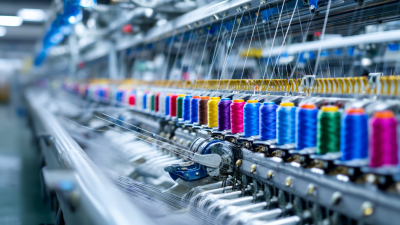Leave Your Message
The evolution of fashion technology has made significant strides in recent years, with the advent of tools that empower creators to personalize their wardrobe. At the forefront of this innovation is the Mini Textile Machine, a groundbreaking device that enables individuals to transform their fashion ideas into reality with ease and efficiency. Fashion industry expert Dr. Emily Carter, a renowned figure in textile engineering, emphasizes the potential of this technology, stating, "The Mini Textile Machine could redefine the boundaries of DIY fashion, making it accessible for everyone to create unique, high-quality garments from the comfort of their homes."
As we delve into the future of DIY fashion, the Mini Textile Machine stands as a symbol of creativity and empowerment. With its compact design and user-friendly interface, it eliminates the barriers that once existed in garment construction. Fashion enthusiasts can experiment with various fabrics, patterns, and techniques, ultimately cultivating a culture of personal expression and sustainability. This new wave of technology not only fosters innovation but also promotes ethical fashion practices, encouraging consumers to reimagine their relationship with clothing.
Looking ahead, the Mini Textile Machine revolutionizes the fashion landscape by highlighting the significance of individuality and craftsmanship in a mass-produced world. As more people embrace this technology, we can expect an exciting surge in homemade designs and personalized fashion statements that celebrate diversity and creativity. The future of fashion is indeed bright, and the Mini Textile Machine is leading the charge towards a more inclusive and imaginative era of self-expression.

The rise of mini textile machines is revolutionizing the DIY fashion landscape, making garment creation more accessible than ever. According to a report by Technavio, the global sewing machine market is expected to grow by over $400 million between 2021 and 2025, with mini machines accounting for a significant share of this growth. These compact devices enable enthusiasts and fashionistas alike to experiment with fabrics in ways that were once limited to professional studios, fostering creativity and personalized fashion solutions.
In this rapidly evolving market, mini textile machines are not just tools; they represent a shift in consumer behavior towards sustainability and customization. A study by McKinsey & Company indicates that nearly 60% of consumers are now prioritizing sustainable fashion choices, driving the demand for DIY solutions that minimize waste and allow for unique, tailored designs. As mini machines become more sophisticated and user-friendly, they encourage a more hands-on approach, empowering individuals to take charge of their fashion journeys while contributing to a more sustainable industry. The convergence of technology, creativity, and sustainability is indeed shaping the future of DIY fashion in profound ways.
The rise of mini textile machines is revolutionizing the DIY fashion industry, offering consumers unprecedented opportunities to express themselves creatively. Recent data from a market research report by Grand View Research indicates that the global DIY fashion market is projected to reach $10.7 billion by 2025, with a compound annual growth rate (CAGR) of 9.7%. This significant growth can be attributed to the innovations in mini textile technology that are making sewing and fabric manipulation more accessible than ever before. With machines now available that feature intuitive interfaces and portability, even beginners can dive into garment creation with confidence.
As mini textile machines become more sophisticated, features such as automatic threading, personalized stitch patterns, and digital integration are driving consumer interest. A survey by Statista reveals that 74% of respondents expressed a desire to engage in DIY fashion projects, particularly among millennials and Gen Z consumers. This demographic is increasingly focused on sustainability and personalization, choosing to create unique pieces rather than purchase mass-produced clothing.
Tips for aspiring DIY fashion enthusiasts:
The DIY fashion movement has been gaining substantial traction over the past few years, with mini textile machines emerging as game-changers in this burgeoning market. According to recent statistics, the DIY fashion industry is projected to grow at a remarkable pace, driven by increasing consumer interest in personalized and sustainable clothing options. Market research indicates that the demand for mini textile machines is set to rise significantly, as they offer users an accessible means to create custom garments and accessories at home. This shift towards self-made fashion reflects broader themes of individuality and eco-consciousness among consumers.
As more individuals seek to express their unique styles, mini textile machines are becoming essential tools for budding designers and hobbyists alike. The ease of use, affordability, and versatility of these machines have made them popular, particularly among younger generations who value creativity and customization. Furthermore, the growing availability of online tutorials and DIY resources supports this trend, empowering users to experiment and refine their crafting skills. This confluence of technology and fashion underscores a dynamic shift towards a more hands-on approach to personal style, indicating that the mini textile machine revolution is just beginning.
This bar chart illustrates the growth of the DIY fashion market over the years from 2018 to 2024, reflecting an increasing trend driven by innovations such as mini textile machines.
As the DIY fashion movement surges, mini textile machines are capturing the attention of diverse consumer demographics. A significant portion of early adopters includes young, tech-savvy millennials and Gen Z individuals who value sustainability and personalization in their fashion choices. These consumers are likely to embrace innovations that allow them to create unique garments at home, signaling a shift away from mass-produced clothing towards more individualized fashion statements. Their digital literacy also facilitates the use of online platforms and tutorials that guide them in using these machines effectively.
In addition to younger generations, mini textile machines are attracting hobbyists and crafters of all ages looking for new forms of creative expression. Older generations, particularly those who have engaged in traditional sewing, find these machines appealing due to their simplicity and ease of use. The compact size makes them accessible for small spaces, encouraging experimentation with different materials. As DIY fashion grows in popularity, the communal aspect of sharing creations and techniques through social media platforms is further driving interest among varied demographics, fostering a vibrant community centered around self-made styles.
| Demographic Group | Percentage Embracing Mini Textile Machines | Main Motivation | Preferred Usage (DIY Projects) |
|---|---|---|---|
| Millennials (Age 25-40) | 47% | Sustainability & Customization | Clothing Alterations, Upcycling |
| Generation Z (Age 18-24) | 35% | Fashion Expression | Unique Fashion Pieces, Accessories |
| Parents (Age 30-45) | 25% | Cost Effectiveness | Children’s Clothing, Fun Projects |
| Hobbyists & Crafters (All Ages) | 60% | Creative Outlet | Various DIY Projects, Home Decor |
| Fashion Students (Age 18-30) | 40% | Skill Development | Fashion Projects, Skill Building |
The rise of mini textile machines marks a significant shift in the realm of DIY fashion, particularly in promoting sustainability through eco-friendly practices. As consumers become increasingly conscious of their environmental impact, the global sustainable fashion market is projected to reach $8.25 billion by 2023, according to research from Allied Market Research. Mini machines allow individuals to create, modify, and repair garments with minimal waste, fitting perfectly into a circular fashion model.
Additionally, these compact devices minimize reliance on mass-produced textiles, which often contribute to substantial waste and pollution. The Environmental Protection Agency (EPA) reports that the clothing and textile industry is responsible for about 10% of global carbon emissions. By leveraging mini textile machines, DIY enthusiasts can utilize repurposed materials, reducing the demand for new textiles and fostering a culture of upcycling. This aligns with recent findings from McKinsey, which highlight that embracing sustainable practices in fashion could reduce greenhouse gas emissions by over 30% by 2030. The convenience of mini machines enables more people to engage in sustainable fashion practices, effectively transforming the industry from the ground up.






